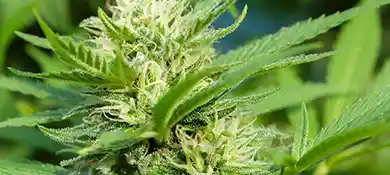Elevate Your Grow: 5 Key Strategies for Humidity Control in HVAC Explained
In the delicate dance of cannabis cultivation, mastering humidity control in HVAC systems is not just a technicality - it's the pulse of the grow room. Precise humidity levels can make or break the health and yield of cannabis plants, turning a promising crop into a bountiful harvest or a cautionary tale.
As cultivators, we chase the sweet spot where temperature and moisture harmonize, giving life to lush, resinous buds. This quest starts with understanding the intricate relationship between HVAC systems and the microclimate they create. Join us as we delve into the essentials of crafting the ideal environment for cannabis to flourish, one where every leaf unfurls under the most favorable of conditions.

Mastering Humidity Control in HVAC Systems
When dialing in the environment for growing cannabis, managing moisture in the air is a game-changer. It's about hitting that sweet spot with humidity - too much and your plant risks mold; too little, and they gasp for hydration.
In cannabis cultivation, the proper humidity control in HVAC systems can guide a plant's transpiration rhythm, directly affecting nutrient absorption and photosynthesis. It’s about fine-tuning the delicate interplay between temperature and air moisture with your HVAC setup to strike a crucial balance, aiming for premium cannabis that hits the mark in taste, strength, and cleanliness.
You can flip through a guide like Cannabis Business Times, which reveals the precision needed in humidity control for thriving cannabis plants. With skilled HVAC humidity manipulation, growers unlock their crop's potential, ensuring their labor yields fruitful results. This process transcends mere temperature adjustments - it's a proactive step towards securing the vitality and vigor of your cannabis yield.
The Importance of Precise Humidity Control in HVAC for Cannabis Cultivation
In the meticulous world of cannabis cultivation, humidity control in HVAC systems becomes a linchpin for success. With careful adjustments to the HVAC system, cultivators can fine-tune the environment, ensuring that each plant receives the exact amount of humidity it craves at every growth stage. This isn’t just fiddling with dials; it’s about providing a consistent atmosphere where the quality and health of the cannabis buds are the top priority.
Understanding the Interplay Between Indoor and Outdoor Humidity
The secret to stellar cannabis yields often lies in the seamless integration of indoor and outdoor climates. An HVAC system is adept at humidity control and shields plants from the erratic shifts of outdoor air, offering a buffer that sustains an ideal growth ambiance. This integration means that even on the muggiest summer days or the driest winter mornings, the indoor habitat maintains an equilibrium that ensures robust plant health and maximized yields.
Balancing HVAC Air Conditioning and Humidity Control
An HVAC’s role extends beyond temperature modulation, directly affecting humidity control in HVAC. A well-adjusted HVAC system ensures that the air is not too dry, which could stress the plants, nor too damp, which could invite pests and disease. Achieving this balance is about nurturing plants in an environment tailored to their well-being, leading to healthy, potent cannabis harvests.
The Role of Heating in Humidity Control through HVAC
Effective heating is another aspect of humidity control in HVAC crucial for peak cannabis cultivation. It wards off the damp chill that can threaten plant health, working with other HVAC components to maintain a precise humidity level. Through this, growers ensure a warm, inviting environment for cannabis plants, setting the stage for a successful cultivation cycle.
Optimizing HVAC Humidity Control for Cannabis Growth
For the cannabis plant, every stage, from seedling to flowering, demands specific humidity settings for optimal growth. An HVAC system that is finely tuned for precise humidity control can lead to robust plant health and significantly increased yield. By leveraging advanced HVAC technology, cultivators can create the ideal microclimate that caters to the unique humidity needs of their cannabis plants throughout their growth cycle.
|
Growth Stage |
Temperature (Day) |
Temperature (Night) |
Humidity |
|---|---|---|---|
|
Germination (Seed) |
70-85°F (20-30°C) |
- |
70-90% |
|
Seedling |
68-77°F (20-25°C) |
Slightly cooler |
65-80% |
|
Vegetative |
70-85°F (20-30°C) |
5-10°F cooler |
40-70% |
|
Flowering |
68-79°F (20-26°C) |
Up to 10°F cooler |
40-50% |
|
Late Flowering/Ripen |
Same as Flowering |
Slightly cooler |
30-40% |
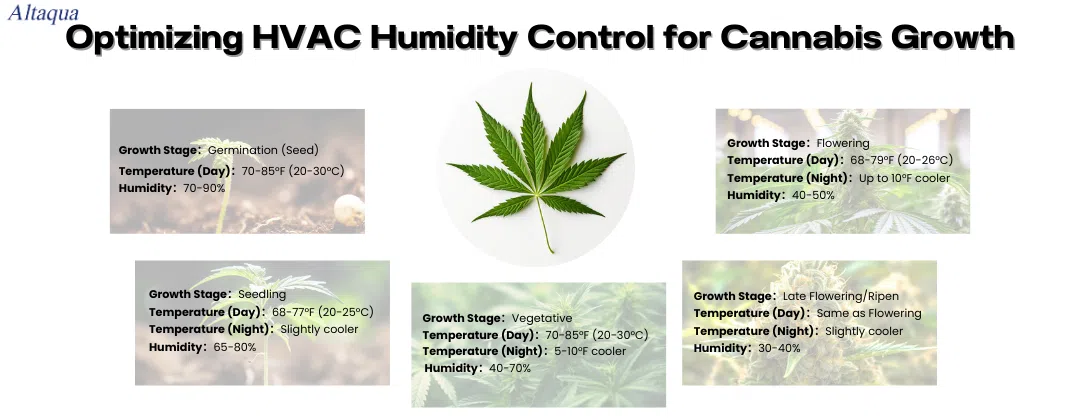
Advantages of Precise Humidity Control in HVAC
Implementing precise humidity control within HVAC systems opens the door to benefits.
- Firstly, it addresses the plant's transpiration needs efficiently, reducing stress and bolstering growth.
- Secondly, it minimizes the risk of mold and mildew - common adversaries in cannabis cultivation that thrive in uncontrolled humidity conditions.
- Moreover, fine-tuning HVAC systems for precise humidity management translates to energy efficiency. It means the systems work less to stabilize the environment, resulting in cost savings over time.
Growers can thus invest more in quality seeds or advanced cultivation techniques instead of footing hefty utility bills.
Enhancing Yield and Quality
Quality and quantity go hand in hand regarding humidity control in HVAC systems for cannabis growth. By optimizing the humidity levels, growers ensure that their plants absorb the right amount of water through their leaves — not too much to cause wilting and not too little to stunt growth. The result is a bountiful harvest of high-quality cannabis that stands out in both purity and potency.
Cost Savings with Efficient Humidity Control in HVAC
1. Energy Efficiency:
An HVAC system optimized for humidity control operates more efficiently. By maintaining stable humidity levels, the system avoids the short-cycling—frequent turning on and off—which is not only hard on the equipment but also consumes more energy. For example, a study by the American Society of Heating, Refrigerating, and Air-Conditioning Engineers (ASHRAE) shows that energy consumption can decrease significantly when a system is maintained at steady operational levels instead of fluctuating.
2. Equipment Longevity:
Constant cycling can cause HVAC components to overheat and wear out prematurely. By keeping the humidity in check, the system runs smoother for longer periods, reducing the need for repairs and replacements. According to the Indoor Air Quality Association, a well-maintained HVAC system can last 15 to 20 years, whereas one without proper humidity control may require more frequent replacements.
3. Product Yield and Quality:
Precise humidity control reduces the risk of mold and mildew, which can spoil entire crops, leading to significant financial losses. A report from MJBizDaily cites instances where growers lost up to 30% of their product due to poor environmental controls, illustrating the cost-effectiveness of investing in a reliable HVAC system.
4. Reduced Downtime:
Efficient systems are less likely to fail, minimizing downtime. For instance, in a case study from a Colorado cannabis facility, an upgraded HVAC system with better humidity control reduced downtime by 20%, enhancing productivity and continuous operation, directly affecting the bottom line.
Designing HVAC Systems for Superior Humidity Control
To thrive, cannabis plants need a tailored environment. Every aspect, from airflow to temperature regulation, must work in unison to maintain the sweet spot of relative humidity that cannabis requires. A well-designed HVAC system ensures that. We're not just talking about cranking up the AC. It's about a system that marries humidity control in HVAC to the unique demands of cannabis. Here's how pros do it:
- Airflow: It's all about circulation. Good air movement prevents damp spots that can ruin a crop.
- Temperature Matching: Warm air holds more moisture. So, the system needs to tweak the temps to keep humidity just right.
- Dehumidifiers: Sometimes, the air's too wet. A dehumidifier connected to the HVAC sorts this out, pulling out excess moisture.
Customizing HVAC Climate Control
When it comes to growing cannabis, one thing’s clear: a customized HVAC system isn't just nice to have; it's essential. The aim? A setup that keeps humidity control in HVAC sharp and responsive, tailored to each growth phase. Advanced HVAC solutions are now able to integrate sensors and controls that adjust the indoor climate dynamically, ensuring that the levels of humidity remain in the ideal range for healthy plant development and potent yields. Here's the inside scoop:
- Smart Sensors: They're the watchful eyes, constantly checking if things get too moist or too dry.
- Automated Controls: The smart system takes the sensor info and tweaks the climate settings on the fly - no manual tweaking is needed.
- Rapid Responsive Systems: It's all about reacting fast. Humidity levels spikes? The system jumps in to fix it.
With advanced HVAC tech, growers are not just maintaining an environment. This dynamic approach keeps humidity levels in the sweet spot, vital for nurturing strong, healthy plants and ensuring they pack a punch with potent yields.
The Pivotal Role of Humidity Control in HVAC
The significance of humidity control in HVAC for cannabis can't be overstated. It's pivotal in preventing mold and mildew, which can devastate a crop, and in facilitating the kind of controlled stress that maximizes THC and CBD content. A finely tuned HVAC system must maintain a delicate balance that only the best designs can achieve, ensuring humidity levels are consistent with plant needs.
Setting Ideal Humidity Parameters with HVAC Systems
Nailing the humidity game with HVAC can catapult a crop from meh to amazing. HVAC systems for cannabis must deliver phase-specific settings and consistent control.
Phase-specific settings mean plants need different air at different times. HVACs need to keep up, from baby sprouts to full bloom. The goal of Consistent Control is to hold that sweet spot of humidity that keeps plants happy without wild swings.
Adapting to Seasonal Changes in Humidity Control through HVAC
As seasons change, so do the humidity requirements of a cannabis grow room. A superior HVAC system can adapt to these changes, providing consistent humidity control without manual intervention. Whether it's the dry air of winter or the moisture-laden breeze of summer, a well-designed HVAC setup can counteract the outdoor elements to maintain a controlled cultivation environment.
HVAC Systems for Effective Humidity Control
Look at how an HVAC system can help regulate and control the humidity in indoor cannabis growth spaces. Humidity control in HVAC system not only solves the problem of your indoor temperature but also regulates humidity significantly.
Various types of HVAC systems are available for indoor cannabis cultivation, including centralized, decentralized, and split systems:
- Centralized HVAC systems
Also known as central air conditioning, all air handling equipment (fans, filters, heaters, coolers, humidifiers, dehumidifiers, refrigeration units, etc.) The system, cooling water circulation system (air-cooled chiller does not need this system), and terminal air treatment equipment, such as air handling unit, fan coil unit, etc.
- Decentralized HVAC systems
This system means using separate units to operate the temperature and humidity in different areas of your grow room. Although they can control temperature and humidity more precisely, they offer more precise control but may be less energy-efficient.
- Split systems
The split air conditioning system comprises an indoor and outdoor unit, connecting pipes, and cables. This type of system is more flexible and allows for project-by-project customization to meet the needs of cannabis growers.
Techniques for Advanced Humidity Management in HVAC
Mastering humidity control in HVAC systems is not just about maintaining a static environment; it's about dynamically adapting to the needs of cannabis plants throughout their growth cycle. You've got to be on your toes, adjusting the vibe of the grow room as your plants go from sprouts to giants. Smart humidity management means healthier plants and beefier buds.
Integrating Dehumidification Solutions in HVAC for Better Humidity Control
Integrating dehumidification solutions into an HVAC system is a cornerstone of effective humidity control in HVAC. State-of-the-art dehumidification systems assist in upholding precise moisture conditions, avoiding the high-humidity pitfalls that can lead to mold and disease in cannabis cultivation. Getting that humidity control in HVAC dialed in right makes all the difference between a crop that's fire and one that flops.
Utilizing HVAC Technology for Accurate Humidity Control Monitoring
Today's HVAC isn't just a bunch of fans and filters - it's high-tech, where smart sensors and controls offer meticulous monitoring and regulation of humidity levels. This tech-enabled approach provides actionable data and automated system reactions.
Think sensors that track humidity to the last percent, giving real-time updates. Then, smart systems take over, tweaking settings in a snap to keep moisture levels in the zone. It's this combo of cutting-edge sensors and automated adjustments that's making sure your cannabis plants are living their best life. Humidity detection and control can be achieved through several means and methods:
|
Method |
Description |
|---|---|
|
Humidity Sensors |
Devices like capacitive and resistive sensors to measure the environmental relative humidity. |
|
Automated Control Systems |
Systems that automatically adjust humidity levels using data from sensors, may include PLCs and central monitoring for comprehensive control. |
|
HVAC Integrated Controls |
Modern HVAC systems with built-in humidity controls that manage both temperature and moisture levels in the air. |
|
Remote Monitoring |
Advanced systems that support monitoring and controlling humidity levels remotely via smartphones or computers. |
|
Smart Algorithms |
HVAC systems with predictive and reactive smart algorithms that optimize humidity levels according to the environmental changes and specific needs of the space or plants. |
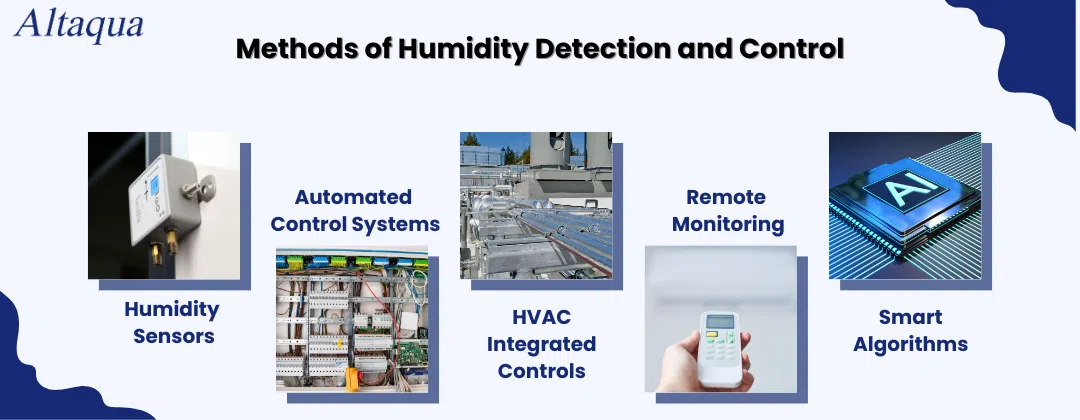
Effective Dehumidification and Humidification Practices
It's not just about removing moisture; sometimes you need to add it. Effective humidity management requires a balance between dehumidification and humidification. By implementing proper practices for both, growers can ensure their HVAC systems are delivering the right amount of moisture to the air, directly influencing the health and potency of their cannabis crops.
Synergy Between HVAC Performance and Humidity Regulation
In cannabis cultivation, achieving the right climate is like conducting an orchestra where humidity control in HVAC is a principal musician playing in harmony with temperature control. Together, they set the stage for cannabis plants to flourish. This means expertly balancing warm and cool air cycles with precise moisture adjustments to maintain a consistent growing environment.
Achieving the Right Temperature-Humidity Balance
The magic in cannabis growth lies in finding the perfect temperature-humidity balance. A responsive humidity control in the HVAC system automatically adjusts to the thermal dynamics of the grow space, ensuring that the atmosphere is always conducive to strong, healthy cannabis plants.
Tailoring HVAC Performance for Seasonal Humidity Demands
As seasons change, so do the demands on your HVAC system for humidity control. A dynamic HVAC system anticipates and adjusts to these changes, ensuring humidity control in HVAC is always in step with seasonal variations. Tailoring your system to respond to these fluctuations ensures that, whether in the heat of summer or the cool of winter, your cannabis crops remain in an environment that promotes optimal growth and health. This foresight guards against environmental stressors that could compromise plant development.
Addressing HVAC Humidification and Dehumidification Needs
A comprehensive humidity control strategy involves humidification and dehumidification components in your HVAC system. Addressing these needs ensures that your cannabis cultivation is not left to the mercy of ambient conditions. This means having an HVAC system capable of detecting and reacting to the subtle changes in humidity that could affect crop yield and potency, ensuring plants receive the right moisture level throughout their growth cycle.
For instance, based on the feedback from sensors, dehumidifiers can remove excess moisture from the air, while humidifiers add moisture when needed to maintain a consistent level of humidity.
Troubleshooting Common HVAC Humidity Challenges
Even the best HVAC systems can encounter challenges, particularly when it comes to humidity control. Understanding how to troubleshoot common issues can save cannabis cultivators time and protect their crops from environmental stress.
Resolving Issues with Oversized AC Units
Oversized AC units can cycle off too quickly, not allowing sufficient time for humidity control in HVAC systems to do their job. Resolving this involves calibrating the system to ensure longer cycles that remove humidity effectively without overcooling the grow space.
Mitigating Negative Pressure Effects on HVAC Humidity
Negative pressure can draw in unconditioned air from outside, disrupting the humidity control in HVAC system. Counteracting this requires sealing leaks and balancing airflow to maintain a stable indoor environment conducive to cannabis growth.
Repairing Duct Leakage to Maintain Desired
Duct leakage is a silent culprit in disrupting humidity control in HVAC systems. Repairing leaks in the ductwork can prevent the loss of conditioned air and help maintain the desired humidity levels critical for cannabis cultivation.
Adjusting Fan Speeds for Humidity Control Efficiency in HVAC
Adjusting fan speeds can have a profound impact on humidity control. Slower speeds allow for better air treatment, while faster speeds can sometimes exacerbate humidity problems by not allowing enough dwell time on the coils.
Maintenance Practices for Sustainable Humidity Control in HVAC
For those nurturing cannabis crops, the upkeep of your HVAC system is more than a routine chore; it's a vital step to sustain the lifeline of your plants. Regular and strategic maintenance can prevent problems before they start, ensuring the system operates efficiently. Growers can keep their humidity control in HVAC systems sharp, avoiding the common pitfalls that lead to inefficiencies or system failures.
Routine Maintenance for Reliable Humidity Management in HVAC
Routine maintenance is the frontline defense in ensuring reliable humidity control in HVAC systems. This includes:
|
No. |
Maintenance Task |
Purpose |
Frequency |
|---|---|---|---|
|
1 |
Filter Inspection and Replacement |
Ensures unrestricted airflow and accurate humidity |
Monthly |
|
2 |
Ductwork Assessment |
Prevents leaks that can disrupt humidity balance |
Annually |
|
3 |
Calibration of Hygrometers and Humidistats |
Guarantees precise humidity control |
Quarterly |
|
4 |
Cleaning of Evaporator and Condenser Coils |
Maintains effective moisture removal |
Biannually |
|
5 |
Drain Line Clearance |
Allows proper escape of moisture from the system |
Each season |
|
6 |
Inspection of Fans and Blowers |
Maintains air circulation for consistent humidity |
Annually |
|
7 |
Review of System Controls and Sensors |
Ensures accurate humidity monitoring and management |
Biannually |
|
8 |
Checking Refrigerant Levels |
Affects dehumidification efficiency |
Annually |
|
9 |
Regular Maintenance for Humidifiers and Dehumidifiers |
Ensuring they respond correctly to the varying needs of cultivation environments. |
Quarterly |
Proactive Seasonal Adjustments for HVAC Humidity
As seasons change, growers must adapt the humidity control in HVAC settings to align with the new environmental demands. For summer, this might mean programming your system for increased dehumidification due to higher ambient moisture. In contrast, winter might call for a reduction in dehumidification efforts as colder air holds less moisture. Such timely adjustments help sustain the right humidity levels for cannabis cultivation year-round.
Strategic Long-term Humidity Control Management in HVAC
Effective long-term management of humidity control in HVAC systems requires foresight and an understanding of seasonal trends. By anticipating the needs of your cannabis crops, you can pre-emptively optimize your HVAC system—upgrading components or tweaking settings before the heavy humidity periods arrive. Keeping a detailed log of past climate fluctuations and plant responses can guide these preemptive measures, ensuring your crops thrive under all conditions.
Daily Monitoring and Adjustments for Stable Humidity Control in HVAC Systems
Daily monitoring allows for quick adjustments to the HVAC system, ensuring stable humidity control. This proactive approach can detect and correct minor issues before they escalate, maintaining an ideal cultivation environment.
A quick check of humidity levels each morning and evening can inform immediate adjustments to the HVAC settings, avoiding the stress that sudden shifts in moisture levels can cause to plants. This kind of hands-on, attentive care can spell the difference between merely surviving and truly thriving cannabis crops.
Concluding Insights on Humidity Control in HVAC for Cannabis Cultivation
Humidity control in HVAC systems is a linchpin in the cannabis cultivation process. As we've seen, the mastery of humidity control in HVAC settings can propel the cultivation process, not just sustaining growth but enhancing the quality and yield of the cannabis harvest.
Elevating Cannabis Cultivation with Advanced HVAC Humidity Control
Today's HVAC setups are game-changers with their advanced humidity control capabilities. They give growers the power to dial in on the exact humidity needed at every growth stage, which means plants get exactly what they need when they need it. These systems are making waves by consistently supporting the cultivation of cannabis that stands out for its quality and robustness.
Altaqua's grow room HVAC systems stand out in the indoor growing scene, packing over 15 years of manufacturing know-how. We're not just building machines; we're engineering environments where humidity levels hit that sweet spot for cannabis cultivation every time.
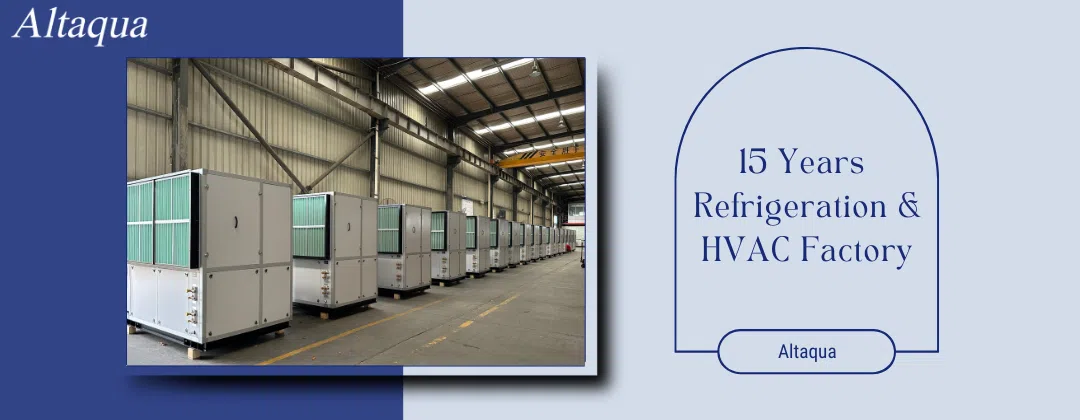
At the heart of our systems are top-tier components sourced from industry giants like Siemens, EBM, Danforss, and Emerson. This isn't just about brand power; it's about performance that you can count on when the growth of your cannabis is on the line.
But here's the real talk: your growth operation is as individual as yours. That's why our crew of seasoned pros is geared up to tailor our HVAC solutions to the nitty-gritty of your project's demands. We put a laser focus on humidity control in HVAC—because we know that's the make-or-break factor in raising hearty, high-yielding cannabis.
Choosing Altaqua means you're plugging into a system backed by industry heavyweights and a team that ensures your greens get the VIP treatment they deserve. We're in this to help you nail that perfect moisture balance, which means lush plants and fat buds. And isn't that what it's all about?
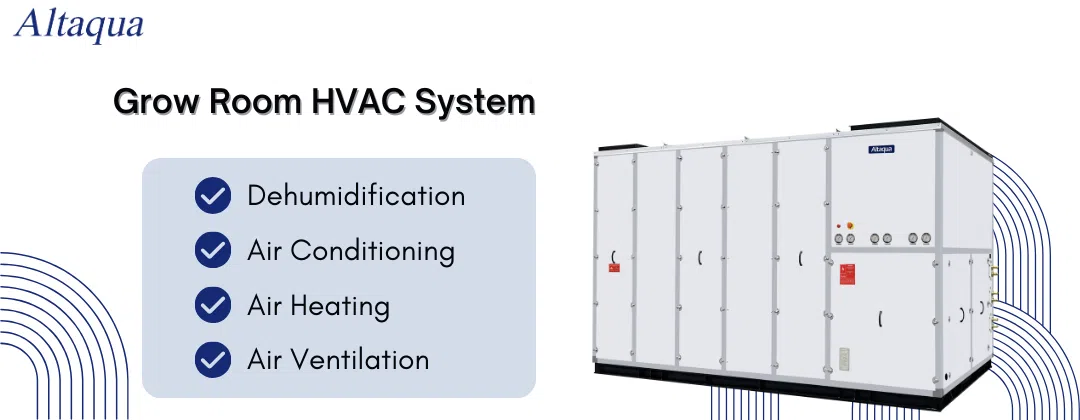
Adopting Best Practices for Humidity Control in HVAC
For growers, adopting best practices in humidity control in HVAC is about precision and responsiveness. It's a dynamic process that tunes into the unique needs of each crop cycle. This might mean adjusting your approach based on the strain, the growth stage, or even the day's weather. It's about creating that "just-right" environment where plants can flourish.
Looking Ahead: Innovations in HVAC for Humidity Control in Cannabis Cultivation
The future of humidity control in HVAC for cannabis cultivation is bright, with cutting-edge developments on the horizon. Innovations are coming fast - think AI that predicts and adjusts climate conditions or new dehumidifying tech that slashes energy costs. These advancements aren't just cool tech; and they are awe-inspiring. As we advance, these innovations will shape and define the standards for optimal cannabis production environments.
FAQ:
1: Why is precise humidity control in HVAC systems crucial for cannabis cultivation?
Precise humidity control in HVAC systems ensures that cannabis plants have the optimal moisture level they need throughout different growth stages, essential for maintaining plant health, maximizing yield, and preventing mold and mildew.
2: Can the humidity control in HVAC systems prevent cannabis plant diseases?
Yes, maintaining the proper humidity levels with an HVAC system can help prevent the growth of mold and mildew, which are common causes of plant diseases in cannabis cultivation.
3: Are there any intelligent features in Altaqua's grow room HVAC systems that help with humidity control?
Yes, Altaqua’s grow room hvac systems can be equipped with smart sensors and controllers that continuously monitor and adjust humidity levels, ensuring precise control over the indoor climate of your cannabis cultivation space.
4: How often do I need to adjust my HVAC system for optimal humidity control in different growth stages of cannabis?
The frequency of adjustments can vary based on the growth stage, but Altaqua’s grow room hvac systems are designed to automatically manage humidity control, minimizing the need for manual changes and simplifying the cultivation process.
Share with your friends:
Popular Blogs on Altaqua:
Get HVAC Brochure?
Get HVAC Brochure?

